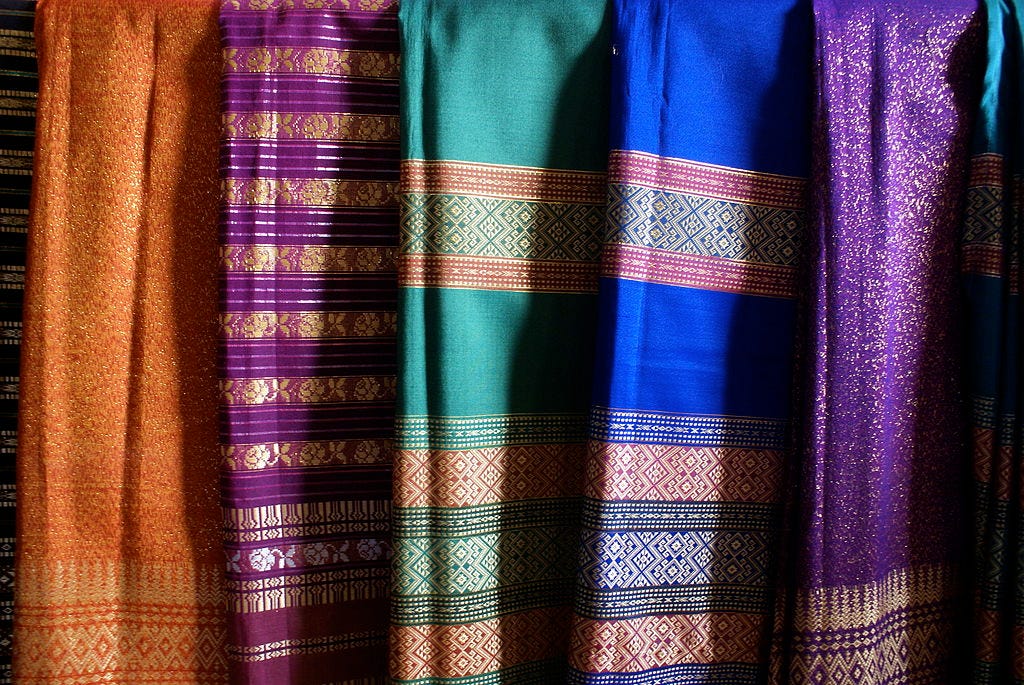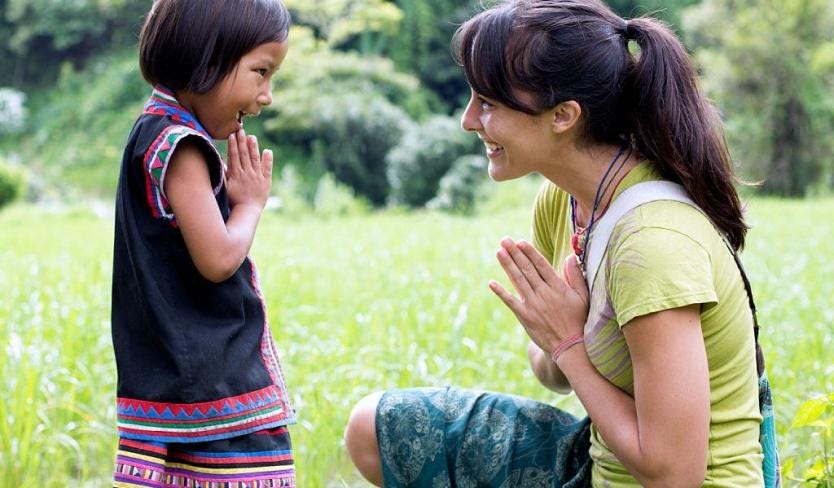Some Delightful Distinctions of Living in Southeast Asia
A look into some of the differences that make life here both peculiar and pleasant
Southeast Asia pulsates with a particular allure and charm. For travellers it’s an easy pass-through to recuperate on sun-drenched beaches and fill up on tasty street food. For expat families working in the region, it’s a comfortable place to explore with the kids.
Each country has its own special character, but overall their are certain qualities of life that are distinctive from the West. I’ve spent the last thirty years absorbing these differences in Malaysia, Thailand, Indonesia, Singapore, Cambodia and the Philippines (and Myanmar back in 1984).
Here’s a hodgepodge of things that might not make the travel brochure highlights, but they make an impact on your sensibilities:
1) Take your shoes off and feel the world at your feet
Westerners are missing the point. Shoes imprison your feet. They keep you locked up in a tight grip. If your eyes are windows to the soul, then your toes are the foundation or the base from which to connect to the ground with your spirit. Too wu-wu? Not really. Haven’t you ever just run wild in a grassy field, felt the warmth of gritty beach sand or oozed thick swamp mud in between your toes.
That is our ancestral foot fetish. Asians never fell for the shoe entrapment theory.
Shoes are not treated well in this part of the world. They are dirt magnets. They belong outside. Most Asian homes have shoe racks or rows of kiddie shoes, dress shoes, business heels and sneakers lined up against the wall. You are entering the home, your shoes are not necessary. There are no rocks to ramble over, no reason for protection.
Asians wear shoes with disdain. They are almost never tied tight and left loose to make their escape easy. The back ends are always beaten down to make any shoe resemble a slipper. For westerners with laced up footwear, you’re going to have to jackknife your body, lean against the wall and rush just to keep others from waiting on you.
The home is where we relax, so why keep your feet fighting the pressure? How do you reduce your mental stress when other body parts are constricted? It makes no sense.
Give your feet the freedom they deserve. Keep your toes connected.
[Photo: Visiting the village headman in Sarawak, Borneo during a forest concession audit.]
2) The simple satisfaction and perfect utility of the sarong
Following the foot freedom theme, it’s time to let your little boys breathe. Life is so much sweeter when you toss off the tighty-whities. Wearing a sarong is the single most effective way to let loose … in entirety.
Asians are experts are making their home life comfortable. First the shoes, then the pants. It’s a ritual. It’s a signal. It says that I am off work hours and attending to my personal needs. I play with the kids. I talk to the neighbors. And I tidy up around the house. Do not bother me with business. Let me relax and recover from the day.
As a former blue jeans and cowboy boot wearer, I may have lost my Texas member card. I now prefer the softness and openness of a sarong ‘dress’. It takes a bit of practice to tie it up tight. I don’t wear it outside the condo beyond the hallways; my confidence level is not that high.
I never travel anywhere without a sarong. It’s the most useful and the lightest piece of apparel to pack. Here is a list of the utilitarian efficiency of the simple sarong:
Use it as a robe, a beach blanket, a bed sheet, a shower curtain or a towel
Use it as a shoulder wrap, a fashion statement or a changing room
Use it as a mosquito net, a seat cover, a light blocker or a head cover
Perfect for crowded airline cabins, super-cooled buses, over lit rooms
Source: https://www.flickr.com/photos/alex-photos/411591109/
3) When it rains and shines, it’s just a state of mind
Living in the tropics means that you live constantly under sun and rain. No snow, no sleet, no polar vortex. Everything swirls around these two conditions. For a few months of the year there is a rainy season when the daily downpours arrive like clockwork. They drench the country with cooling waters, nourish the rainforests and flood the city streets.
In temperate climates, winter is a time to cleanse the environmental palate. Heat dissipates to remove the sweltering stew of sewage, garbage and other festering pools. The pesty bugs of summer die off and disappear. In tropical climes, there is only temporary relief from the sporadic wash downs of afternoon splashes.
I love rain. In the deserts of Sudan, I collected rain as it settled on the flat roofs and ran down the drain pipes into 55-gallon metal drums. This water was good for cleaning, flushing toilets and washing clothes. During the dry season, a man in a donkey-driven cart would go house-to-house and sell slick water from oil barrels. So I never complain about rainy days.
When it rains in the tropics, you jump into action. The first move is to bring in the dry clothes sunning outdoors. The second move is to start closing up the windows to prevent indoor wet spots. Rains causes the city to take a breathe. Cars switch to crawl speed and exposed motorcyclists congregate under overpasses to wait out the heavy stuff. The rain dampens the urban heat sink and the air feels fresh and moist.
As for the sun, it always shines. No vitamin D deficiency here. It does get toasty, especially on the coastal plains. But having perpetual sun means never having to say, “get my jacket” or “go warm up the car”.
It is all bliss and a bit of sweat, whether rain or shine. The Beatles know what I’m talking about. Here’s the chorus to Rain:
Rain … I don’t mind.
Shine … The weather’s fine.
4) The avoidance of conflict as a personal ultimatum
America is watched closely. As street protests, police beatings and opportunistic looting fill the airwaves, Asians look in awe and wonder what the hell is going on. A Malaysian friend asked me this week, “Are Americans really so aggressive?”.
It’s tough to explain the nature of Americans to outsiders. My own take is that we are so ingrained with individual rights ideology that it overrides a sense of community or self-sacrifice. We fight hard and in your face. It’s not altogether a negative quality, it just causes havoc from time to time.
In contrast, and as a general rule, Asians hate conflict. They avoid it at all costs. It is impossible to go face-to-face with someone who does not want to lose it. Do not construe this behavior as a weakness, it is actually a strength. Conflict aversion takes patience, guts and fortitude. It also defuses a hot button moment. It absorbs the rancor of the other person and leaves them with no where to go with their vitriol.
Americans like to vent and push the bounds of a personal right to be right. We are supported by the Constitution, the culture and a subsection of the populace. We rarely take the time to step back, reconsider the opposing side or resolve the situation without displays of anger and attacks.
Do not be mislead that a non-combative response is ineffective or cowering. Asians have long memories and short forgiveness. They just play the game different. They will use a third party or wait until another occasion to get payback or revenge.
It is better to realize that flying-off-the-cuff is a temporary advantage. Avoid the small conflicts and save the real protests and anger for the things that matter most, like racism, police brutality, war and fighting for marginalized people.
[Source: JoanBrown51 at Pixabay.com]
5) Simple gestures from the essence of humility
Nothing exemplifies the essence of Asia as much as the simple gestures of respect made throughout the region’s cultures. They convey a recognition of your presence, a welcoming to a home or an honoring of elders. All of these acts of humility demonstrate a sense of dignity from all parties.
In Thailand, the wai greeting, a two-handed palm pose from the chest or face with a slight head bow, is a delightful way to say hello and goodbye. It signifies that you are accepted to join us. By keeping a polite distance without touching hands, it provides a way to show respect without getting too close. Each party has appropriate space. The wai exemplifies the elegance of the culture.
In Malaysia, there are three particular gestures that highlight the recognition and regard for others. I have incorporated these movements into my own daily practice.
Bow Walk Through (Tumpang Lalu) - When entering a crowded room of people sitting on the floor and furniture, it is impolite to plow through them without bowing from the midsection and straight-arming your right hand down to the ground. It is an act of lowering yourself to avoid being an intrusion in passing, even if over 6 foot tall. This is so automatic to my sensibilities now.
Hands to Heart (Salam) - When greeting another person, two hands are used to clasp them together at waist level before reaching back to your heart or chest with your palms and fingertips swiping away at your shirt gently. This gesture symbolizes that the person is bringing you into their heart.
I am so predisposed to greet this way. Once on a visit to Texas, my friend took me to a neighborhood summer party. Upon meeting the host, I clasped hands and motioned my hands to my shirt to show respect. She immediately apologized and looked at her hands to see if they were wet or dirty. You can take the boy out of Southeast Asia, but …
Head to Hands (Salam) - Younger generations pay respects to elders by holding an outstretched hand between both or their own. Then the younger person bows and taps their head atop the clasped hands. As an older person, I am on the receiving end of this greeting.
All of these gestures now seem to be even more appropriate in the coronavirus age. Maybe the handshake is too close, too personal and too aggressive. Keeping a slight distance allows you to be friendly without stepping across a fine line. Reverence and respect needs to be earned.
[Source: Thailand Travel Agency]
Southeast Asia is enduring for many reasons. These are just some of my favorite cultural quirks and geographic benefits.
My appreciation to you for taking the time to read these selections and essays. I hope you find some enjoyment and insights about the world we live in. Thanks for supporting and sharing Continental Drift.
— Rick Scobi (@rickscobi)








